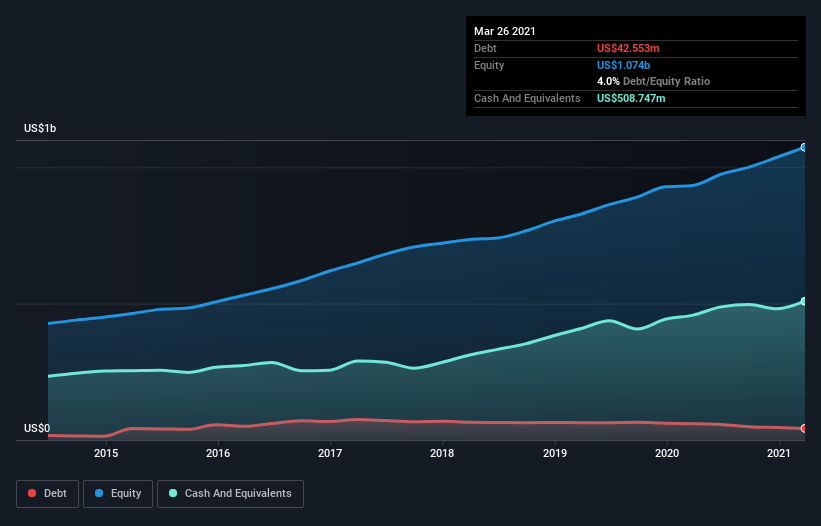Fabrinet (NYSE:FN) Seems To Use Debt Rather Sparingly
Legendary fund manager Li Lu (who Charlie Munger backed) once said, 'The biggest investment risk is not the volatility of prices, but whether you will suffer a permanent loss of capital.' When we think about how risky a company is, we always like to look at its use of debt, since debt overload can lead to ruin. We can see that Fabrinet (NYSE:FN) does use debt in its business. But should shareholders be worried about its use of debt?
What Risk Does Debt Bring?
Debt is a tool to help businesses grow, but if a business is incapable of paying off its lenders, then it exists at their mercy. If things get really bad, the lenders can take control of the business. However, a more common (but still painful) scenario is that it has to raise new equity capital at a low price, thus permanently diluting shareholders. By replacing dilution, though, debt can be an extremely good tool for businesses that need capital to invest in growth at high rates of return. When we think about a company's use of debt, we first look at cash and debt together.
See our latest analysis for Fabrinet
What Is Fabrinet's Net Debt?
The image below, which you can click on for greater detail, shows that Fabrinet had debt of US$42.6m at the end of March 2021, a reduction from US$59.9m over a year. But it also has US$508.7m in cash to offset that, meaning it has US$466.2m net cash.
How Healthy Is Fabrinet's Balance Sheet?
Zooming in on the latest balance sheet data, we can see that Fabrinet had liabilities of US$366.2m due within 12 months and liabilities of US$62.1m due beyond that. Offsetting these obligations, it had cash of US$508.7m as well as receivables valued at US$350.5m due within 12 months. So it actually has US$430.9m more liquid assets than total liabilities.
This surplus suggests that Fabrinet has a conservative balance sheet, and could probably eliminate its debt without much difficulty. Succinctly put, Fabrinet boasts net cash, so it's fair to say it does not have a heavy debt load!
And we also note warmly that Fabrinet grew its EBIT by 14% last year, making its debt load easier to handle. There's no doubt that we learn most about debt from the balance sheet. But ultimately the future profitability of the business will decide if Fabrinet can strengthen its balance sheet over time. So if you want to see what the professionals think, you might find this free report on analyst profit forecasts to be interesting.
Finally, a company can only pay off debt with cold hard cash, not accounting profits. Fabrinet may have net cash on the balance sheet, but it is still interesting to look at how well the business converts its earnings before interest and tax (EBIT) to free cash flow, because that will influence both its need for, and its capacity to manage debt. During the last three years, Fabrinet generated free cash flow amounting to a very robust 86% of its EBIT, more than we'd expect. That puts it in a very strong position to pay down debt.
Summing up
While it is always sensible to investigate a company's debt, in this case Fabrinet has US$466.2m in net cash and a decent-looking balance sheet. And it impressed us with free cash flow of US$75m, being 86% of its EBIT. So is Fabrinet's debt a risk? It doesn't seem so to us. When analysing debt levels, the balance sheet is the obvious place to start. However, not all investment risk resides within the balance sheet - far from it. These risks can be hard to spot. Every company has them, and we've spotted 1 warning sign for Fabrinet you should know about.
At the end of the day, it's often better to focus on companies that are free from net debt. You can access our special list of such companies (all with a track record of profit growth). It's free.
This article by Simply Wall St is general in nature. It does not constitute a recommendation to buy or sell any stock, and does not take account of your objectives, or your financial situation. We aim to bring you long-term focused analysis driven by fundamental data. Note that our analysis may not factor in the latest price-sensitive company announcements or qualitative material. Simply Wall St has no position in any stocks mentioned.
Have feedback on this article? Concerned about the content? Get in touch with us directly. Alternatively, email editorial-team (at) simplywallst.com.

 Yahoo Finance
Yahoo Finance 
